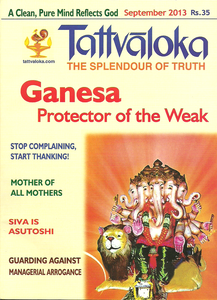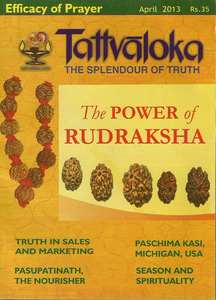Chapter 2 Section 5. Introduction The section is called Madhu Brahman because the word Madhu which means honey or helpful occurs repeatedly in it. The madhu vidya of ChAndogya Upaniṣad is Surya upAsanA. In Br Up it refers to Atma vidya or Brahma vidya. There are different techniques by which the Upanishads teach the knowledge of the Self. One method is creator and creation. Brahman is the creator. and world is the creation. This has been talked about earlier. Madhu Brahman uses the method of inter-dependence among worldly objects. They are mutually dependent and are mithyA. Therefore, there must be some entity outside the world which lends existence to the worldly objects. This entity is Brahman or the Self. The Upanishad also says that Brahman only appears as the world like gold appearing as ornaments. The ornaments are names and forms. Similarly, the world of multiplicity are names and forms. Brahman is all pervading and is present in a jIva as also in all other worldly objects. If a person understands this, he knows all and becomes immortal.
Tag Archives: jivatma
BrihadAranyaka Upanishad (Part 2)
1.4.7
The mantra has core teaching of Vedanta, namely, Brahman is satya, jagat is mithya, and jiva is not different from Brahman. Brahman is all-pervading pure existence. Pure existence is same as pure consciousness. Existence and consciousness are two aspects of Brahman. It is eternal and changeless. It has mAyA power which is a relative reality because it borrows existence from Brahman. MAyA is the aggregate of sanchit karmAs of all the jivAs at the end of one cycle of creation which rests in Brahman in unmanifest and potential form. At appropriate time, the world is projected due to mAyA power. The creation unfolds in stages starting from five elements in nascent forms. The undifferentiated Brahman appears as differentiated names and forms called world. At some stage, jivAs with gross and subtle bodies are created which are inert and they enclose the all-pervading consciousness. It is like a pot enclosing space. The enclosed consciousness is jivAtma. This phenomenon is figuratively described as entry of Brahman. It is like a waking man entering the dream. When the dream is over, the waking man says that he has experienced the dream. It means that the entity which experiences the waking state also experiences the dream.
Eight Upanishads (Topic-wise) Part 39
Chapter 7 Brahm Sutra Bhasya
7.5 BSB 3.2.31 to 3.2.37: Brahman is one without a second
There is a view that there is something different from Brahman on account of the terms, embankment [Setu- Ch 8.4.1], measure, connection and difference. Isvara is the protector of dharma etc. jivAtmA is the protected. It suggests that jivAtmA and ParamAtmA are different, one is the Setu, the protector and other things are protected (Ch Up 6.8.1). Lokas rest on Bhagavan (Katha 2.3.1). From “having crossed over the embankment”” (Ch Up 8.4.2), it is gathered that just as in life somebody crosses a stream over the embankment to reach solid ground, which is other than the embankment, so also one crosses over this embankment, that is the Self, to reach something that is not the embankment of the Self.
Eight Upanishads (Topic-wise) Part 38
Chapter 7 Brahma Sutra Bhasya
7-4 BSB 3.2.22 to 3.2.30 Unconditioned Brahman and soul Neti neti means negation of two things and question is which are the two things negated. Purva Paksi argues that they are Brahman the substance and the attributes. According to Siddhanta negation of both leads to nihilism. Neti neti does not negate Brahman. It is negation of the attributes and not Brahman. Denial of Brahman is not reasonable, for that would contradict the introduction made with, “I will tell you of Brahman” (Br. 3.1.1), as also the condemnation contained in such texts as, “If anyone knows Brahman as non-existent, he himself becomes non-existent” (Tai. 2.6.1), and the affirmation, “The Self is to be realised as existing” (Ka. 2.3.13), “The knower of Brahman attains the highest”, “Brahman is Truth, Knowledge, Infinity” (Tai. 2.1.1). The text “Failing to reach which, words turn back with the mind” (Tai. 2.9.1) points to Brahman.
Tat Tvam Asi (Part 2)
Existence inheres every worldly object. Before creation, all the worldly objects are in seed (unmanifest) form in Existence and the creation unfolds gradually. Existence manifests everywhere whereas consciousness is manifested in subtle body only, e.g., mind, intellect. A jiva is a mind-body system and is sentient and has emotions of happiness and sadness. Consciousness (Chit) does not undergo any change as it is present in the mind like a reflection (ChidAbhAsa. It is individual self or individual soul ( jivAtmA).
Eight Upanishads (Topic-wise) Part 27
Chapter 6 JnAna and Moksha
6-7 Mundaka Upanishad
6-7-4 Mundaka 2.2.1 and 2.2.2 The Upanishad explains how Brahman can be known though it is formless. It is subtler than the subtlest. It shines through all experiences. It is cognized in the hearts of all beings as revealing Itself through such functions as seeing, hearing, thinking, knowing. It is therefore very near for wise. It is the support of all living and non-living things, all the worlds and the dwellers of the worlds like all the spokes fixed on the navel of the chariot wheel. It pervades all that is subtle and gross, yet not polluted by and is beyond them. It is the highest goal and the most desirable. By knowing It one is contented as if all desires are fulfilled.
Eight Upanishads (Topic-wise) Part 17
Chapter 6 JnAna and Moksha
6-4 Kaivalya Upanishad
6-4-1 Kaivalya 8 to 10
Brahman is the only reality. The empirical world has borrowed existence. Brahma, Vishnu, Siva, and Indra are manifestations of Brahman. The empirical world beginning with time and unfolding of vital forces and fire are manifestations of Brahman. By knowing that Brahman as Self, one conquers the tyranny of death that batters everyone. By Self-knowledge only, one can cross the scourge of time. There is no method other than this. Karma Yoga, UpAsanA Yoga and Bhakti Yoga are supportive disciplines for purifying the mind for gaining knowledge.
Bhagavad Gita (Topic-wise) Pt18
6 Moksha
6-1 Preparation
6-2 Jnana, Jnani, and Jnana-Phala
6-2-3 Six definitions 8(1 to 4) The last two verses, 29 and 30 of the 7th chapter have introduced some terms without explaining them. 8th chapter begins with Arjuna’s question to know these terms, namely, Brahm, Adhyatam, Karma, Adhibhutam, Adhidaivam, and Adhiyagna. Brahm is the supreme imperishable entity. It is a pithy answer because, in the 7th chapter, Para- prakriti has been explained in detail as the imperishable entity, namely, consciousness. It pervades the creation. As such, it is within the body also. The embodied consciousness is Adhytama. Brahm is consciousness from a macro angle, Adhyatma is the same consciousness from a micro angle.
upadesha sAhasrI – Part 22
 Part 22 of the serialization of the presentation (compiled by R. B. Athreya from the lectures given by Swami Paramarthananda) of upadesha sAhasrI. This is the prakaraNa grantha which is agreed by most experts to have been written by Shankara himself and is an elaborate unfoldment of the essence of Advaita. Note that this is the concluding part of the series.
Part 22 of the serialization of the presentation (compiled by R. B. Athreya from the lectures given by Swami Paramarthananda) of upadesha sAhasrI. This is the prakaraNa grantha which is agreed by most experts to have been written by Shankara himself and is an elaborate unfoldment of the essence of Advaita. Note that this is the concluding part of the series.
Subscribers to Advaita Vision are also offered special rates on the journal and on books published by Tattvaloka. See the full introduction
upadeSha sAhasrI – part 17
Part 17 of the serialization of the presentation (compiled by R. B. Athreya from the lectures given by Swami Paramarthananda) of upadesha sAhasrI. This is the prakaraNa grantha which is agreed by most experts to have been written by Shankara himself and is an elaborate unfoldment of the essence of Advaita.
Subscribers to Advaita Vision are also offered special rates on the journal and on books published by Tattvaloka. See the full introduction

